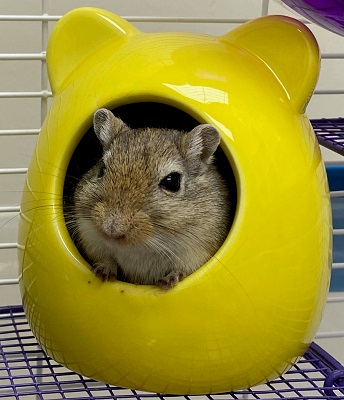
March 2022 is about to march into the history books and we too must march on as we say good-bye to our current Animal of the Month, the gerbil. We hope that you enjoyed following us on Twitter @ExoticPetVets as we tweeted all month long about these social animals. But if you missed any of our tweets, you can find a summary of them right here. Did you know?:
- Of the approximately 110 species of gerbils, the most common one kept in captivity is the Mongolian gerbil (Meriones unguiculatus). They are also known as Mongolian jirds, sand rats and desert rats.
- As their name suggests, wild Mongolian gerbils are found in Mongolia. They are also found in areas adjacent to Mongolia in southern Siberia and northeastern China.
- The natural habitats for wild Mongolian gerbils include deserts, semi-desert areas, and dry steppes (open grasslands). They can also be found in fields and in areas with clay soil.
- The habitats where wild Mongolian gerbils live are subject to extreme weather conditions, ranging from summer temperatures that can reach 50 degrees Celsius. In the winter, temperatures can drop to a low of -40 Celsius.
- In the wild, Mongolian gerbils will dig burrows, which are used as their homes. They will dig near plants so the roots can act as a support system for their burrows to ensure their homes are sturdy.
- A typical Mongolian gerbil burrow averages about a half-metre underground and consists of several chambers – one is the nest and the rest are used to store food.
- Mongolian gerbils not only use their burrows to sleep, but they also use them to escape from extreme weather conditions and hide from predators.
- In their burrows, Mongolian gerbils live in small family groups. The females outnumber the males, but the group is led by an alpha male who is larger than the others.
- Gerbils use scent and salivary cues to identify family members and figure out their social structure.
- The members of a Mongolian gerbil family group will all contribute to their food stores. While they are social animals, they are also territorial and will defend their burrows from other gerbils.
- Mongolian gerbils are slender rodents and grow to an average length of 10 cms (4 inches) from the nose to the base of their tails.
- Mongolian gerbils have long slender tails are an average of about 10 cms (4 inches) in length and are covered in fur with a small tuft of fur on the end.
- Because Mongolian gerbils live in underground burrows, their heads are adapted for burrowing. Compared to rats, gerbils have heads that are shorter and more broad.
- Wild Mongolian gerbils have light cream coloured or off-white undersides. The rest of their fur is called agouti, which consists of each hair being irregularly banded with several different colours giving them an overall dull brown colour.
- But because of selective breeding, captive Mongolian gerbils can be seen in a variety of fur colours, including white, grey, black, dark brown and tan.
- While their diet skews heavily towards being vegetarian, Mongolian gerbils are actually omnivores; meaning, they eat both plant and animal matter.
- In the wild, Mongolian gerbils will eat fruits, grasses, flowering plants, bulbs, seeds, roots and insects.
- In 2015, rats were exonerated from their long-standing reputation of being responsible for spreading the Black Plague in Europe – gerbils were blamed for it instead.
- Researchers from the University of Oslo said at the time that flea-infested gerbils brought the plague to Europe from central Asia by ship.
- But further study by Norwegian and Italian researchers appears to exonerate gerbils too. Researchers said in 2018 that it was humans – and neither rats nor gerbils — who spread the Black Plague with their body lice and fleas.
- With proper care, gerbils in captivity can live an average of 3 – 5 years.
- But in the wild, the Mongolian gerbil lifespan is much shorter because of the presence of predators and the potential of natural disasters. Some sources estimate that wild gerbils typically live only a few months to a year.
This is the third time we have featured gerbils as our Animal of the Month – all in the month of March too! Check out our blog posts from March 2015 and March 2018 to see what we tweeted about gerbils the previous two times we shone the spotlight on them.

